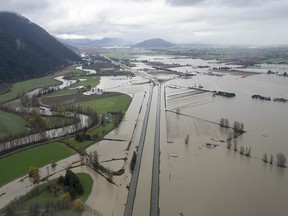A have a look at the meteorological time period bomb cyclone and why we have by no means heard of it earlier than

With the primary huge fall storm hitting B.C. this week, people may marvel why they’re listening to the time period “bomb cyclone” to explain it.
Right here’s what to learn about winter climate on the coast, what atmospheric rivers and bomb cyclones are, and why climate specialists preserve a detailed eye on them.
What are atmospheric rivers?
The autumn and winter climate sample for British Columbia’s coastal areas is usually moist and steadily windy, marked by a gradual circulate of storms that often kind over the Pacific Ocean.
These storms mostly come within the type of an atmospheric river — what meteorologists colloquially known as a Pineapple Specific, says Alyssa Charbonneau of Atmosphere and Local weather Change Canada.
The extra scientific time period atmospheric river was first coined by researchers at MIT within the Nineteen Nineties.
Atmospheric rivers — a big storm filled with plenty of subtropical moisture and often accompanied by robust, doubtlessly damaging winds — are quite common on the west coast from the top of summer time till spring.
Elements of B.C. often see upwards of 30 or 40 atmospheric rivers every fall and winter of various depth.
“They’ll vary from a web optimistic, recharging rivers and reservoirs, and they are often very devastating as nicely,” says Charbonneau. “They arrive in numerous flavours,” all the best way from common previous wet days to main wind and flooding occasions.
Given our usually dry summers, the sequence of atmospheric rivers is vital to sustaining the strong water provide B.C. enjoys. They supply greater than half of B.C.’s annual ingesting water.
However once in a while, as was the case in November 2021, an atmospheric river hits that causes widespread flooding and injury. Charbonneau says that storm was the most important and most impactful she’s seen in her lifetime.
The extent of the damaging results of an atmospheric river is dependent upon its sheer scale, the place it hits land and the way lengthy it lasts, says Charbonneau.
What about bomb cyclones?
Like atmospheric rivers, bomb cyclones are nothing new. Each phrases are generally bandied about amongst meteorologists for many years, however the media and public not often heard them described that method till lately.
A bomb cyclone, often known as bombogenesis, describes a fast drop in atmospheric strain on the centre of a storm system.
If the barometer on the eye of the storm drops shortly sufficient — roughly 24 millibars over the course of 24 hours — it’s known as a bomb cyclone.
“It’s a method of describing a storm system that’s quickly intensifying,” explains Charbonneau, noting that’s precisely what occurred on the centre of this primary fall storm over the weekend.
The atmospheric strain on the centre of the present storm is not dropping precipitously, nevertheless, and the form of winds we’re seeing Monday may not be a giant concern in the event that they got here later within the season.
That’s as a result of it comes whereas the timber have plenty of foliage on them and are extra inclined to weakening and breaking as a result of they haven’t needed to climate robust winds for a very long time. “In November (this storm) wouldn’t be as regarding.”
Simply to confuse issues, a bomb cyclone can generally be a part of an atmospheric river, although they’re not almost as frequent, says Charbonneau.
Is local weather change making these storms worse?
“A number of the literature does present that there was a slight improve” within the frequency and depth of atmospheric rivers and bomb cyclones, says Charbonneau, although some seasonal storms have all the time been huge and damaging.
We’ve had some “main, impactful atmospheric rivers” in recent times, she says, and it’s necessary to arrange for the chance they may worsen because the local weather evolves.
“There are some indicators and indicators that we are going to be seeing extra excessive occasions sooner or later,” says Charbonneau.
But it surely’s additionally necessary to keep in mind that, regardless of the novelty of the phrases getting used in recent times, they’re “not new and commonplace.”